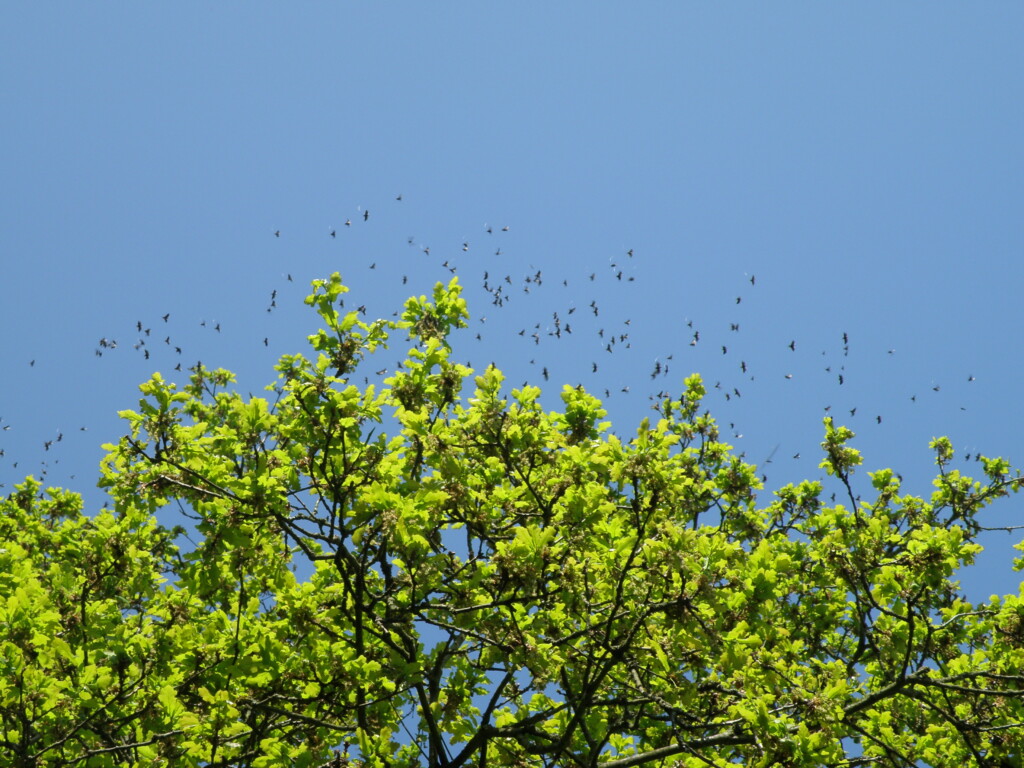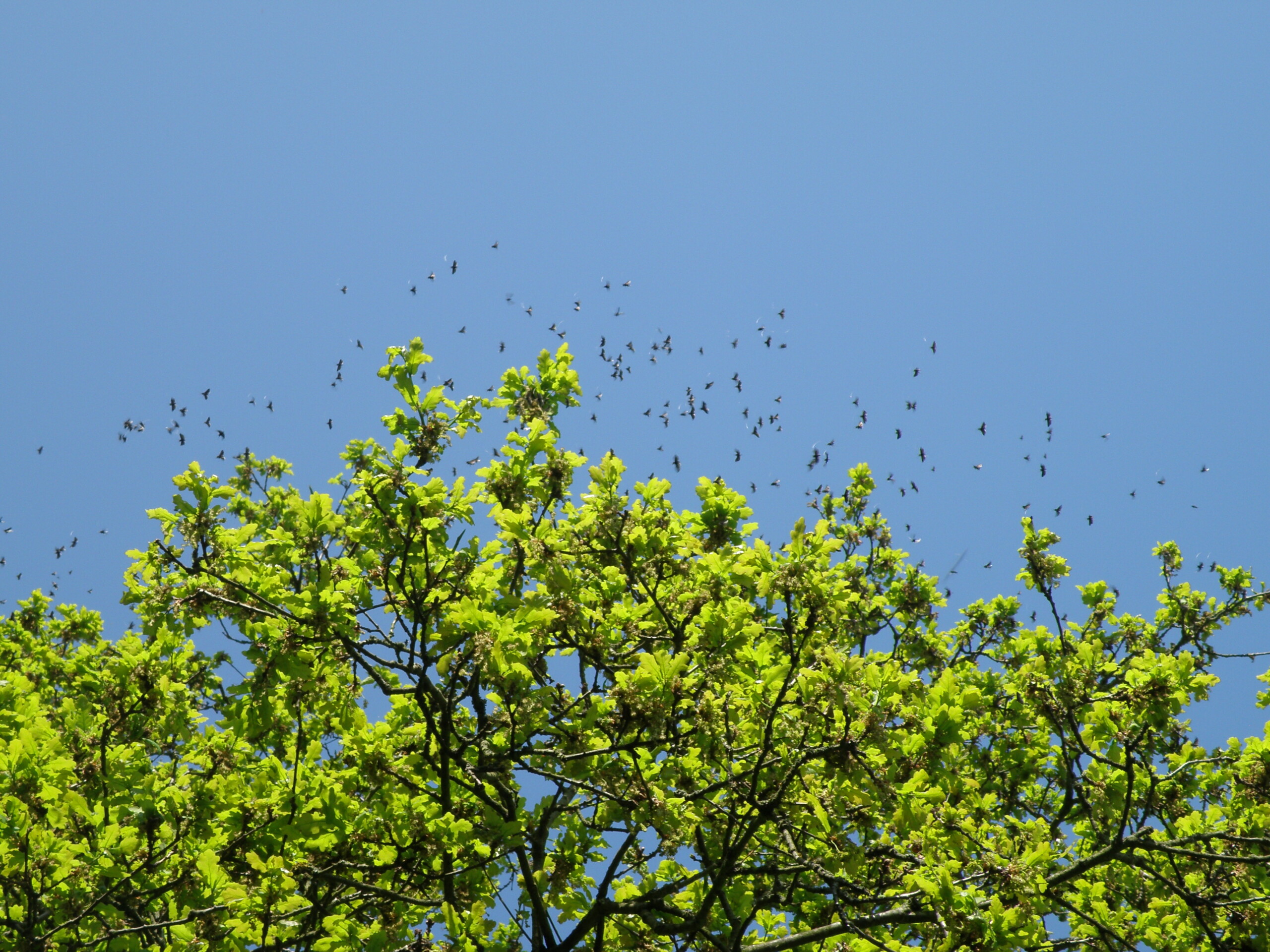Roger Morris highlights the concerning lack of insects present this spring. Read the full editorial below:
A lovely sunny morning in early June 2023, and I have arrived at Chiddingfold Woods in southwest Surrey, a site well known for its insects, with nationally important butterfly and moth populations. The conditions look good, but are there any insects about? Elsewhere this spring, numbers have been so dire that, on several occasions, I have returned home almost in tears at the lack of insect life. Will my luck change today? I start at 10am, early enough to catch insects basking in the morning sunshine, but where are they?
The woods are quiet, deathly quiet. No birdsong and no hum of insect life. I wander down the track and in the first half hour I fail to see a single hoverfly. Eventually I spy individuals of Myathropa florea and Helophilus pendulus and so my list develops, but pathetically slowly. In the whole day, I manage to see 18 species by visiting six localities. At this time of year, in such a good area, a count well into the 40s should be possible.
My subsequent post on the UK Hoverflies Facebook page elicits similar responses of woe from almost everybody. The story, it seems, is repeated across the country, but what is the cause? Have habitat loss and pesticides obliterated all insect life? Perhaps pesticides are as pervasive as is claimed, but is there really so much import of these chemicals from insect movement and bird and animal droppings? In the Chiddingfold area, where there is almost no agriculture, that seems unlikely. Others I talk to suggest that we had a harsh winter, but this is surely an example of shifting baselines: in comparison with the late 20th century, winter 2022/23 was completely unexceptional. What if it is not cold that is to blame for this dearth of insects, but heat?
In the past 18 months, broken climate records have been not the exception but the norm. In early July, for the first time since monitoring began, the global average temperature breached 17°C – and remained there for 11 of the following 14 days (to the point of writing). This followed the hottest June on record globally, during which the 1.5°C threshold – the trigger for ‘irreversible and devastating consequences for both human populations and the environment’, according to the IPCC – was breached. Figures for North Atlantic sea-surface temperature and (lack of) Antarctic sea-ice are being not just beaten but smashed, while at the time of writing countries across the Northern Hemisphere, from the USA to China, are experiencing heatwaves with routine exceedance of regional temperature records.
In a crisis that is unfolding across the globe, the UK obviously has not escaped. The Met Office reports that June 2023 was the hottest since records began, in 1884, and a staggering 2.5°C warmer than the norm for just the last three decades alone – an average already raised by anthropogenic global warming to well over temperatures from earlier in the 20th century. Maximum June temperatures usually lie in the upper teens or low twenties (ideal for insect activity), but in 2023 surpassed 25°C for at least a fortnight, breaching 30°C in some locations. This persistent heat was combined with depleted rainfall, at 68% of average for the UK as a whole, and followed a May in which rainfall was almost half the normal level. Thus, conditions for another heatwave/drought episode – like the ‘unprecedented’ heatwave of summer 2022 – were established.
Meanwhile, the evidence for climate-driven effects on invertebrates is mounting. A recent study of Mediterranean forest insects (Uhl et al. 2022) found a strong negative correlation between high temperatures and the abundance of moths whose larvae develop during summer months, a particularly alarming finding given that these are faunas adapted to hotter climates. In Britain, analysis by Palmer et al. (2017) has shown that the severe drought of 1976 had the single largest negative impact on butterfly and moth populations of any climatic event in a 50-year dataset. Clearly, extreme heat and drought have the potential to harm insects that feed on plants, but what of the overwhelming majority of invertebrates with other feeding strategies? It is essential that more attention is given to impacts on decomposers, filter-feeders, predators and parasites, and especially the faunas of damp soils.
For these latter groups, soil-moisture deficit is surely a critical but as yet poorly understood factor in observed declines (see BW 33: 13–20). Conditions in May and June highlight the severity of the challenge. Our insect fauna is adapted to relatively cool, moist conditions – not prolonged heat and drought. Larval stages of many species are particularly vulnerable, given that these may require standing water or damp soil for their survival. As these are gradually depleted during the course of drought, potential habitat for larvae – and egg-laying sites for the adult insects – can be reduced virtually to nothing. And if we think that the situation is bad today, we must brace ourselves for much worse to come. Recent analysis by Wilson & Pescott (2023) predicts that, at current rates of warming, a swathe of south-east England will experience an Iberian/Mediterranean climate by the 2060s. Spring 2023 is merely a harbinger of the catastrophe to come.
We know from studies of better-known groups, such as butterflies, that the most severe declines have occurred in highly specialised species (Fox et al. 2022). Yet in terms of grabbing the public’s attention, the most important stories are not those in which rarities are disappearing, but in the loss of familiar sights of the urban and rural landscape. My own records tell a compelling story. Some formerly abundant multi-generational species such as the hoverfly Melanostoma scalare almost disappeared in the summer and autumn of 2022 and were at an extremely low ebb in spring 2023. This year, it was also noticeable in my part of south London that dancing clouds of the longhorn moth Adela reamurella were singularly absent: I saw a small cloud of about 20 on one day but nothing like those of past years. And what about the St Mark’s Fly Bibio marci, males of which also form leks close to bushes? This year the numbers of individuals I saw did not reach double figures. These are the canaries in the climate-change coal mine, and they are starting to fall silent – we ignore their warning at our peril.
Surely, it is time to put a lot more effort into understanding the impacts of climate change on invertebrates. If this season’s tales of woe are anything to go by, ecosystem collapse is a lot closer than we might like to think. At the time this article is being written, forecasters are predicting July 2023 to be not just the warmest July, but the hottest month on record globally since monitoring began. If hot, dry summers become a permanent fixture in south-east England, it could mark the end for many invertebrate species in the region.
References
Fox, R., Dennis, E. B., Purdy, K. M., Middlebrook, I., Roy, D. B., Noble, D. G., Botham, M. S., & Bourn, N. A. D. 2022. The State of the UK’s Butterflies 2022. Butterfly Conservation, Wareham.
Palmer, G., et al. 2017. Climate change, climatic variation and extreme biological responses. Philosophical Transactions of the Royal Society B 372: 20160144.
Uhl, B., Wölfling, M., & Bässler, C. 2022. Mediterranean moth diversity is sensitive to increasing temperatures and drought under climate change. Scientific Reports 12: 14473.
Wilson, O. J., & Pescott, O. L. 2023. Assessing the exposure of UK habitats to 20th- and 21st-century climate change, and its representation in ecological monitoring schemes. Journal of Applied Ecology; https://doi.org/10.1111/1365-
2664.14455.
Roger Morris is an entomologist and joint organiser of the Hoverfly Recording Scheme.

